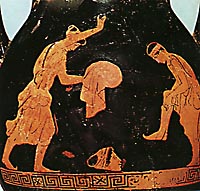
The
myth:
The story which the playwright turns into a play - the
plot, in other words. The subjects of myths in drama were
drawn by the playwrights from mythology, very rarely from
history.
Lexis (Diction): The way the playwright handles
language and text.
Melos (Tunes): The musical elements of the play.
Opsis (Visuals): Stage sets and costumes.
Props: Mask, costume appropriate to the gender,
age, rank and character of the principal character,
symbols of authority.
Originally
masks were of clay; later they
were of leather. They portrayed the constant character of
the hero schematically.
Costume and
buskins
(shoes with platform soles) were worn by actors to give
the human body superhuman stature. All these elements,
whether they went beyond the scenic means or were used in
parallel with them, helped alienate the spectator from
the actor.
Ethos (Temper): The character of a hero of drama;
the way he/she reacted to circumstances.
Dianoia (Intent): The way the playwright expressed
his own thoughts, ideas and views on the world and life
in general through his heroes; and also the techniques he
used to support these views of his.



